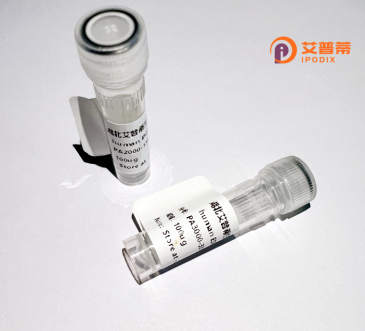
| 纯度 | >90%SDS-PAGE. |
| 种属 | Human |
| 靶点 | LRMP |
| Uniprot No | Q12912 |
| 内毒素 | < 0.01EU/μg |
| 表达宿主 | E.coli |
| 表达区间 | 1-555aa |
| 活性数据 | MESTPFSGVANQIHTLCERPTYGEVKDGALDVKRQHKCPGPTSGPSPGTNLSGCIRMNDDPSMEENGVERVCPESLLQSREYSSLPLPRHTSSTDGTITSSDPGLEILNMASCDLDRNSLCKKEEDTRSASPTIEAQGTSPAHDNIAFQDSTSKDKTILNLEAKEEPETIEEHKKEHASGDSVVSPLPVTTVKSVNLRQSENTSANEKEVEAEFLRLSLGFKCDWFTLEKRVKLEERSRDLAEENLKKEITNCLKLLESLTPLCEDDNQAQEIIKKLEKSIKFLSQCAARVASRAEMLGAINQESRVSKAVEVMIQHVENLKRMYAKEHAELEELKQVLLQNERSFNPLEDDDDCQIKKRSASLNSKPSSLRRVTIASLPRNIGNAGMVAGMENNDRFSRRSSSWRILGSKQSEHRPSLPRFISTYSWADAEEEKCELKTKDDSEPSGEETVERTRKPSLSEKKNNPSKWDVSSVYDTIASWATNLKSSIRKANKALWLSIAFIVLFAALMSFLTGQLFQKSVDAAPTQQEDSWTSLEHILWPFTRLRHNGPPPV |
| 分子量 | 62.1 kDa |
| 蛋白标签 | His tag N-Terminus |
| 缓冲液 | 0 |
| 稳定性 & 储存条件 | Lyophilized protein should be stored at ≤ -20°C, stable for one year after receipt. Reconstituted protein solution can be stored at 2-8°C for 2-7 days. Aliquots of reconstituted samples are stable at ≤ -20°C for 3 months. |
| 复溶 | Always centrifuge tubes before opening.Do not mix by vortex or pipetting. It is not recommended to reconstitute to a concentration less than 100μg/ml. Dissolve the lyophilized protein in distilled water. Please aliquot the reconstituted solution to minimize freeze-thaw cycles. |
以下是3-4条关于重组人LRMP蛋白的参考文献摘要概括:
---
1. **文献名称**:**"LRMP/Jaw1 is a lymphoid-restricted protein associated with the endoplasmic reticulum membrane"**
**作者**:Behrens, T.N., et al.
**摘要**:该研究首次克隆并表达了人源LRMP蛋白(也称Jaw1),发现其选择性表达于淋巴细胞中,并通过实验验证其与内质网膜的结合关系,推测其在淋巴细胞亚细胞定位中发挥作用。
---
2. **文献名称**:**"Biochemical characterization of LRMP-mediated interactions in immune cells"**
**作者**:Shikano, S., et al.
**摘要**:研究通过重组人LRMP蛋白的体外表达,结合免疫共沉淀技术,揭示了LRMP与STIM1蛋白的相互作用机制,表明其可能参与调控钙离子信号通路及免疫细胞活化。
---
3. **文献名称**:**"Structural insights into LRMP function through recombinant protein crystallography"**
**作者**:Kiyonaka, S., et al.
**摘要**:该研究利用重组LRMP蛋白进行了结晶和结构解析,揭示了其C端结构域的关键作用,并证明LRMP通过特定结构域参与调节内质网-细胞膜间的信号传导。
---
4. **文献名称**:**"Role of LRMP in B cell receptor signaling via recombinant knockdown models"**
**作者**:Sato, Y., et al.
**摘要**:通过构建重组LRMP敲除的B细胞模型,研究发现LRMP缺失会抑制B细胞受体的信号传导,表明其对淋巴细胞发育和免疫应答至关重要。
---
这些文献涵盖了LRMP蛋白的克隆表达、结构解析、相互作用机制及功能研究,可作为相关领域的核心参考。
Lymphoid-restricted membrane protein (LRMP), also known as JSP.1 or BAT2. is a leucine-rich repeat-containing protein predominantly expressed in immune cells, particularly B and T lymphocytes. First identified in the 1990s, LRMP is anchored to the endoplasmic reticulum (ER) membrane and structurally characterized by multiple leucine-rich repeats (LRRs) and phosphorylation sites. Its primary function remains under investigation, but studies suggest roles in modulating immune responses, potentially through interactions with MHC class II molecules and ER-associated protein trafficking. LRMP has been linked to immune regulation, with evidence implicating it in autoimmunity, lymphocyte activation, and antigen presentation pathways. Recombinant human LRMP protein is engineered using expression systems (e.g., E. coli, mammalian cells) to produce purified, functional domains for mechanistic studies. Researchers utilize it to explore LRMP’s binding partners (e.g., BAT3), signaling cascades, and its influence on immune cell differentiation. Ongoing research focuses on its therapeutic potential in immune disorders and cancer, as dysregulated LRMP expression correlates with altered immune surveillance. Its recombinant form enables structural analysis, antibody development, and high-throughput screening for drug discovery. Despite limited natural abundance, recombinant LRMP provides critical insights into its enigmatic biological roles.
×